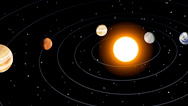What's Your Favorite Planet?
- By Susan K. Lewis
- Posted 01.01.10
- NOVA
The scientific debate over Pluto's planetary status has rallied thousands of Pluto lovers to show their support. But is Pluto more popular than Saturn or Mars or our own home planet? What about the little-known but arguably fetching dwarf planets Ceres and Eris? In this poll, hear 11 astronomers and planetary scientists make a "30-second pitch" for their celestial contestants. Then pick your favorite.
 Launch Interactive
Launch Interactive
Listen in as 11 planetary scientists make pitches for the "best" planet, then vote yourself.
Transcript
MERCURY
Distance from sun (avg.): 36 million miles
Time it takes to orbit sun: 88 Earth days
Size (diameter): 3,032 miles (two-fifths of Earth)
Surface Temperature (range): -275 to 840 ºF
Number of Moons: 0
Discovered: Known in ancient times
Origin of Name: Roman god, the swift messenger
Sean Solomon
Carnegie Institution of Washington
Principal Investigator for NASA's MESSENGER mission, which will reach Mercury in 2011.
Mercury is the underdog planet. It's the smallest guy in the neighborhood, and it lives in the roughest part of town—high temperature, strong solar wind. But little Mercury is tough. It's made out of the densest material. It's experienced a long and really interesting history of volcanic eruptions and faulting and impact cratering. It's managed to keep it's internal magnetic field when its larger sister planets have lost theirs, and that magnetic field help shield the surface from solar wind ions. Those ions continuously strip Mercury's atmosphere, but Mercury has a way to keep regenerating that atmosphere with material from its own surface. Finally, Mercury, despite being in the hottest part of the solar system, manages to keep what looks to be water ice at the poles. For there to be water ice on the planet closest to the sun is also quite a surprise. So Mercury gets my vote as the small guy who manages despite the odds being stacked against him.
VENUS
Distance from sun (avg.): 67 million miles
Time it takes to orbit sun: 225 Earth days
Size (diameter): 7,520 miles (roughly Earth-size)
Surface Temperature (range): 113 to 870 ºF
Number of Moons: 0
Discovered: Known in ancient times
Origin of Name: Roman goddess of love
Ellen Stofan
Proxemy Research
Stofan, a planetary geologist, has researched tectonic and volcanic activity on several planets, including Venus.
The whole reason we study the planets is really to come back home and try to understand how our planet, Earth, works. There's nowhere better in the solar system to go to achieve that than Venus. Venus is about the same size as the Earth, it's made of the about same materials. But Venus is an entirely different planet. It's about 900 degrees F on the surface. It's surface is covered with volcanoes. It's baking under a greenhouse atmosphere that we can use to better understand how the Earth's climate works. But it's like you started with two chocolate cake mixes, put them both in the oven, and one came out chocolate and the other came out lemon. Why did it evolve so differently than Earth? In understanding that, we will understand a lot more about the Earth, the fate of our planet, the history of our planet.
EARTH
Distance from sun (avg.): 93 million miles
Time it takes to orbit sun: 365 Earth days
Size (diameter): 8,000 miles
Surface Temperature (range): -127 to 136 ºF
Number of Moons: 1
Discovered: n/a
Origin of Name: Anglo-Saxon word for ground or soil
Randy Friedl
NASA's Jet Propulsion Laboratory
Friedl, an expert on Earth's atmosphere, is deputy director for research in JPL's Engineering and Science Directorate.
You know the famous phrase, "There's no place like home?" I think Earth is interesting because it's unique. And it's unique because it has an abundant quantity of water, and that compound has enabled life to exist on Earth, which is an incredibly unique property as well. Secondly, Earth is interesting because it's variable. When people say, "If you don't like the weather, just wait a minute." It doesn't just apply to the atmosphere, it applies to the two other great fluids on Earth, if you will, which is the oceans and land surface. And the oceans have tides and currents that move heat. The plate tectonics shape the land and help moderate the climate system. And it's the interaction between these three great fluids that is such a challenge. It's so tremendously complex that it beckons further understanding. But finally, perhaps, I would say that Earth is the most interesting, because we humans are participants in the system. And you can see it from space that we literally are changing the face of the Earth through our activities. And it's clear now that as we confront climate change, that we must understand the workings of our home planet if we are to be good stewards of it.
MARS
Distance from sun (avg.): 142 million miles
Time it takes to orbit sun: 687 Earth days
Size (diameter): 4,214 miles (half of Earth)
Surface Temperature (range): -195 to 70 ºF
Number of Moons: 2
Discovered: Known in ancient times
Origin of Name: Roman god of war
Bruce Banerdt
NASA's Jet Propulsion Laboratory
Banerdt is Project Scientist for the Mars Rovers Spirit and Opportunity, which have been exploring Mars since 2004.
Well, I think Mars is unique because it's at the same time bizarre and familiar. You have a sky, but it's pink. You have sunsets, but they're blue. You have mountains, but they're 15 miles high, and canyons, but they're three miles deep. And so you have all this really strange stuff, but it's still at a scale that we can experience as humans. Plus, it's affordable—it's just about the easiest planet to get to. And scientifically the reason that Mars is particularly appealing to me is that we're interested in the early evolution of the solar system—the differentiation of planets into core and crust and mantle. And Mars has experienced all these processes. But at that point in its history, before plate tectonics started roiling everything up, it stopped its geological evolution, to a large extent. So all the clues to that early history are still preserved in the rocks and in the structure of Mars as a planet. And so it's a window into all the important processes of planetary formation.
CERES
Distance from sun (avg.): 257 million miles
Time it takes to orbit sun: 1,680 Earth days
Size (diameter): 590 miles (one-thirteenth of Earth)
Surface Temperature (range): -254 to -36 ºF
Number of Moons: 0
Discovered: 1801 by Giuseppe Piazzi
Origin of Name: Roman goddess of harvest/motherly love
Mark Sykes
Planetary Science Institute
Sykes is director of the Planetary Science Institute and co-investigator of NASA's Dawn mission, due to orbit Ceres in 2015.
Ceres is the largest object between Mars and Jupiter. It's located in the Asteroid Belt. And we've all seen asteroids as irregularly-shaped, potato-like bodies. I was part of a team that looked at Ceres with the Hubble Space Telescope and discovered that, unlike every other asteroid, it was a round object like other planets. And it's molded into that shape by its gravity. And we have some other evidence from an orbiting telescope back in the '90s that Ceres may have a thin atmosphere. But the most exciting thing about Ceres is we think it may have a liquid water ocean underneath its surface. And that begs the question—could there be life in that ocean? Ceres is the littlest planet that no one knows about. You know, learning more about it would be great. It's also the closest and most easily accessible example of what is probably the most common kind of planet in the solar system—these ice-rich, dwarf or small planets. And most importantly, if Ceres has a sub-surface ocean, whose water we can access on its surface, it could provide the key to understanding how life came about on the Earth. So I can hardly wait for Dawn to get there, to see if there's evidence for that.
JUPITER
Distance from sun (avg.): 484 million miles
Time it takes to orbit sun: 12 Earth years
Size (diameter): 88,846 miles (11 Earths)
Surface Temperature (range): -261 to -186 ºF
Number of Moons: at least 63
Discovered: Known in ancient times
Origin of Name: King of Roman gods
Scott Bolton
Southwest Research Institute
Bolton is Principal Investigator of NASA's Juno mission to Jupiter, due to launch in August 2011.
Jupiter was recognized to be a really important planet even by the ancient Greeks, who named it Zeus, and Zeus was the king of the gods. And the planet is huge. The planet is so big that it has most of the solar system in it. If I took all the solar system except for the sun it would all fit inside of Jupiter. And that planet, that giant planet is buzzing around in only 10 hours. So it's rotating really fast. Its day is only a fraction of the Earth's day. And, finally, the reason that it's a really important planet is that it guards the Earth. And it guards it by taking comets that are on their way in that might hit us, and using its gravity to grab them and fling them out into the outer solar system. Otherwise, they might hit the Earth, and knock life out, much the way the dinosaurs went extinct.
SATURN
Distance from sun (avg.): 891 million miles
Time it takes to orbit sun: 29.5 Earth years
Size (diameter): 74,900 miles (nine Earths)
Surface Temperature (range): -301 to -188 ºF
Number of Moons: at least 61
Discovered: Known in ancient times
Origin of Name: Roman god of agriculture
Carolyn Porco
Space Science Institute
Porco is director of the Cassini Imaging Central Laboratory for Operations (CICLOPS), where she oversees imaging of Saturn.
Out of all the planetary systems in our solar system, Saturn is the most phenomenologically rich, and it makes it like the Promised Land where we can go to understand not only about the Saturn system in particular, but about many of the big questions we have about how the solar system got here, how it was configured to look the way it does today, and also what makes the Earth the incredibly successful abode of life that it has become. Saturn has Titan, which is the only moon in our solar system that has an extensive atmosphere and therefore it has a surface environment that in many ways resembles the surface environment of here on the Earth. So it allows us the opportunity to examine what processes might have gone on the early Earth before the emergence of life. Saturn has this extensive set of rings, the grandest in all the solar system. I think Saturn is not only the most scientifically promising of all the places we could visit in the solar system, it also happens to be the most beautiful and the most photogenic.
URANUS
Distance from sun (avg.): 1.8 billion miles
Time it takes to orbit sun: 84 Earth years
Size (diameter): 31,763 miles (four Earths)
Surface Temperature (range): -355 ºF
Number of Moons: 21 known
Discovered: 1781 by William Herschel
Origin of Name: Roman god of the sky
Nancy Chanover
New Mexico State University
Chanover and her graduate students study the atmospheres of Uranus and other planets using visible and infrared imaging and spectroscopic techniques.
Well, poor Uranus has had a pretty rough life. Early on in its history, astronomers believe that it was impacted by a large, Earth-size impactor, and this caused the planet to tip over on its side. So now its rotation axis is pointed almost in the same direction as its orbit around the sun. So this makes Uranus pretty unique in our solar system. It results in very unusual seasons on that planet. And each pole on Uranus spends approximately 42 years in darkness followed by 42 years in sunlight. And Uranus just went through Equinox in 2007, so now we are seeing many new storm clouds in its atmosphere. And it's becoming quite an interesting place. So the planet has gone from being an underdog ice giant to being one of the most fascinating planets in our solar system. It's anything but boring.
NEPTUNE
Distance from sun (avg.): 2.8 billion miles
Time it takes to orbit sun: 165 Earth years
Size (diameter): 30,775 miles (3.5 Earths)
Surface Temperature (range): -373 ºF
Number of Moons: 11 known
Discovered: 1846 by Johann Gottfried Galle
Origin of Name: Roman god of the sea
Heidi Hammel
Space Science Institute
Hammel served on the Imaging Science Team for NASA's Voyager 2, the first spacecraft to closely observe Neptune.
I think Neptune is one of the coolest planets in the solar system because it's got everything there. It's got a thick atmosphere. It's got a really cool ring system that's all chunky, not uniform like Saturn's. It's got a really interesting moon system, including one moon, Tritan, that was captured—it was not born in orbit around Neptune—it was sort of like a Pluto that was captured by Neptune. It's got a really interesting magnetic field that's offset and tilted. So it's just got everything that a planetary scientist could want. And it's all wrapped up in one beautiful blue planet.
PLUTO
Distance from sun (avg.): 3.6 billion miles
Time it takes to orbit sun: 248 Earth years
Size (diameter): 1,400 miles (one-fifth of Earth)
Surface Temperature (range): -375 ºF
Number of Moons: 3 known
Discovered: 1930 by Clyde Tombaugh
Origin of Name: Roman god of the underworld
Alan Stern
Southwest Research Institute
Stern is Principal Investigator of NASA's New Horizons, the first mission to explore Pluto, which it should reach in 2015.
The reason that I think Pluto is the coolest planet is partially because it's on the frontier, and the frontier of our knowledge. Pluto is a very special kind of object technically called a "planetary embryo"—a planet that was arrested in mid-gestation, as it was growing up. You know, it's the little planet that could. And it holds for us the chance to see what planets were like in the early stages of their formation. Moreover, it's got three moons, a really complicated atmosphere, and seasons, and polar caps, and who knows what else we'll find. And I just think it's the coolest world out there, that we know of.
ERIS
Distance from sun (avg.): 9.7 billion miles
Time it takes to orbit sun: 557 Earth years
Size (diameter): 1,491 miles (a tad bigger than Pluto)
Surface Temperature (range): -411 to -382 ºF
Number of Moons: 1 known
Discovered: 2005 by Mike Brown
Origin of Name: Greek goddess of discord and strife
Mike Brown
California Institute of Technology
Brown discovered the dwarf planet Eris, a breakthrough that helped prompt a new definition of planethood.
Eris is my favorite body out there in the solar system. For one reason, it's the most distant thing that we've ever seen, which in itself is kind of cool. But it really is the important object that made us re-think what the outer solar system is like. The outer solar system is not big Pluto and then a bunch of small Kuiper Belt objects. It's a lot of objects like Eris, like Pluto, like these other dwarf planets that are all the leftover chunks from the early solar system. It is really far away right now, but it comes in almost as close as Pluto. Its atmosphere right now is frozen to the surface. The atmosphere comes back to life when it comes closer in. It freezes back up again. It's a complex, fascinating little world to study.
Credits
Images:
- (solar system)
- The International Astronomical Union/Martin Kornmesser
- (Sean Solomon)
- Courtesy Carnegie Institution of Washington
- (Mercury, Mars, Earth, Venus, Saturn, Jupiter, Uranus, Neptune)
- Courtesy Lunar and Planetary Institute
- (Ellen Stofan)
- Courtesy Ellen Stofan
- (Randy Friedl)
- Courtesy JPL
- (Bruce Banerdt)
- Courtesy Caltech/JPL/NASA
- (Ceres)
- NASA, ESA, J. Parker, Southwest Research Institute, P. Thomas, Cornell University, L. McFadden, University of Maryland, College Park, and M. Mutchler and Z. Levay, STScI
- (Mark Sykes)
- Courtesy Mark Sykes
- (Scott Bolton)
- Courtesy Scott Bolton
- (Carolyn Porco)
- Courtesy Carolyn Porco
- (Nancy Chanover)
- Courtesy Nancy Chanover
- (Heidi Hammel)
- Courtesy Heidi Hammel
- (Pluto)
- NASA/JPL-Caltech/R. Hurt, SSC-Caltech
- (Alan Stern)
- Courtesy Alan Stern
- (Eris)
- NASA, ESA, and M. Brown, Caltech
- (Mike Brown)
- Courtesy Mike Brown
Related Links
-

The Pluto Files
Take a cross-country journey with Neil deGrasse Tyson to explore the rise and fall of America's favorite planet.
-

Hate Mail From Third Graders
See what some outraged but loving kids had to say to astrophysicist Neil deGrasse Tyson about "demoting" Pluto.
-

In Defense of Pluto
Alan Stern, head of NASA's New Horizons mission to Pluto, stands up for the little guy.
-

Tour the Solar System
Explore the planets, visit the moon, and gaze at the stars in this 3-D interactive model of the solar system.
-

Notes From the Pluto Files
Neil deGrasse Tyson describes what it was like to meet Clyde Tombaugh's family and other people passionate about Pluto.
You need the Flash Player plug-in to view this content.

